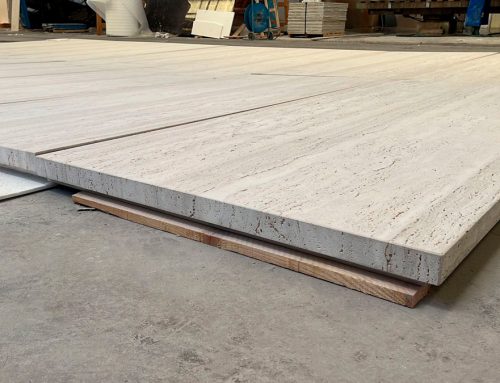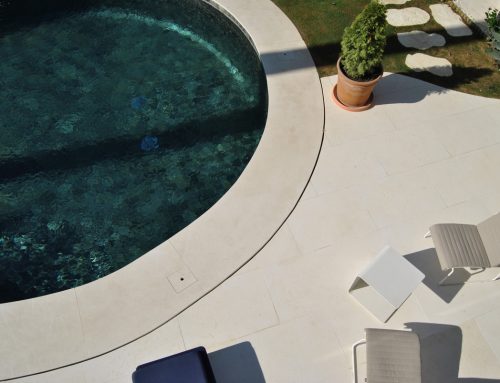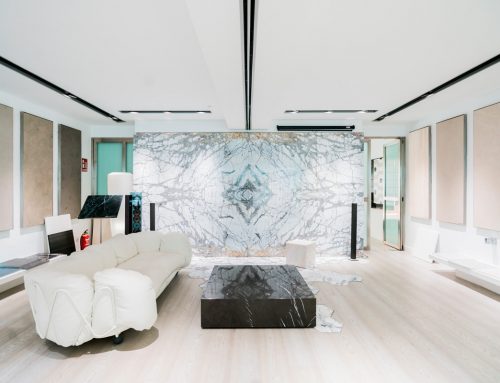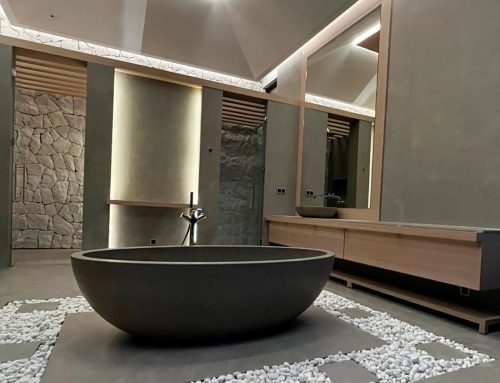Until recently, a project with large format slabs almost necessarily required using porcelain due to its low thickness and lower weight. Today, however, Stonesize, the reference brand in lightweight stone, allows large-format coverings using lightweight natural stone panels. The aesthetic result of natural stone is spectacular, especially when compared to porcelain tiles that imitate stone patterns. The porcelain pieces, as imitations, try to simulate the streaks and colors of the stone using serial printing.
Porcelain tile vs. lightweight natural stone panels: here we compare their strengths and weaknesses.
Design trend: the large format

Large format is a trend, and technological advances in the materials industry allow stone panels of a size previously unthinkable. Architects and designers use the latest innovations to provide eye-catching results with their projects.
Natural vs. artificial
Every piece of stone is unique. The uniqueness and expressiveness conveyed by marble slabs are unparalleled. Moreover, the pattern of its veins or gaps can’t be repeated in a series. The marbles, onyx, limestones, and quartzites, among others, are the result of the whims of nature, not created by man. Whoever is looking for a material with unique design has to resort to natural stone. The mass production of synthetic materials such as porcelain can never simulate the magic of nature.
Fashion

Year after year, the leading trade fairs in the ceramic sector emphasize large format and stone imitations. It is not unusual to discover replicas of well-known marbles such as Calacatta or Negro Marquina, although they can also imitate quartzite and even onyx.
In these cases, the quality of these imitations is equal to the quality of the printing of their drawings. These are repeated printings, which, even if they are high resolution, inevitably provide the same density throughout the texture of the surfaces. In this aspect, natural stone is unmatched.
Textures

The textures of the ceramics are simple. They are reduced to those that can be generated in the pressing process. However, in the case of natural stone, an infinite world of finishes and textures opens up. The finishes in natural stone can range from polished to split face, through different levels of sandblasting, flaming or honing.
As for the textures, they are also totally customizable. An excellent example is the textile textures of TINO Natural Stone, or the waterjet technique, advantageous when it comes to achieving customized textures.
Weight

Until now, the great advantage of porcelain was that it generated pieces for the large format with a low weight/m2, easy to handle and install.
Today, with Stonsesize, these sizes, thicknesses, and weights are also achieved for natural stone, reaching the large format with even lower weights (20 kg/m2).
Unfamiliarity
It is the only disadvantage of lightweight natural stone versus porcelain: a large number of architects are not yet familiar with it. Otherwise, they would apply it in their large format projects without hesitation.

Precio
Stonesize is a new design tool for architects and designers who often used porcelain because they were unaware of the existence of this alternative of 100% natural stone. Traditionally, large format stone applications (whole slabs) were discarded by designers due to their weight, and therefore the difficulty in handling and installing them. Thus, historically, the stone was relegated to the small format.
Today, just as porcelain tile has evolved from small to large format, the stone has also developed thanks to technological advances. The result is Stonesize.
Price

In the comparison of porcelain vs. light natural stone panels, price is an element that can make the difference depending on the quality and uniqueness required in the project.
The high-quality marbles, onyx, quartzites, or calcites of Stonsize panels are exclusive and premium materials. They are not cheap and do not have the essential concept of making the material cheaper in any of the stages of its production. Therefore, they cannot be compared with porcelain prices. As we would say in colloquial language, “they play in different leagues.” Natural stone has value in itself, and a porcelain tile lacks value.
It should be noted, from the placement of very exclusive marbles such as Portoro, Stonesize lowers the price concerning the standard m2 of that marble, since we significantly limit its consumption.
Care
Porcelain has optimum properties for maintenance because it is a synthetic material that seeks strength. However, as a 100% natural material, stone needs more knowledge a priori. In other words, a specialist must advise on which type of stone is most suitable for its future application. For example, stones that are too porous tend to absorb more stains or moisture and therefore, will not be indicated for countertops, bathrooms, or exteriors. Fortunately, there is a type of stone for any project.
Do you want to know more about porcelain tile vs. lightweight natural stone panels? Contact us >









